May has arrived, and with it comes a fresh bouquet of wildflowers! From brilliant magenta to yellow speckles and a bit of everything in between, check out what's beginning to bloom this month.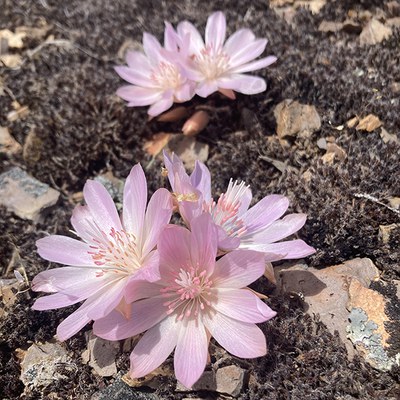
Other common names: none
An absolute showstopper in the desert! Bitterroot is part of the purslane family. It has a green rosette of small, fleshy leaves. Flowers are a vibrant deep rose, pink, or sometimes white, up to 2" wide. Bitterroot blooms very close to the ground. The plants remain dormant through the summer. Bitterroot is named for Merriwether Lewis, who collected the first specimens in the Bitterroot Mountains of Montana in 1806. The plant is widespread in the western US and grows in dry shrublands.
Bloom time: all spring
Land Trust Preserves: You can see bitterroot at Whychus Canyon Preserve, as well as on a Land Trust outing at Coffer Ranch or Willow Springs Preserve.
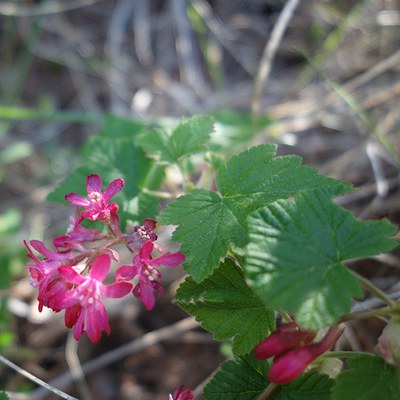
Other common names: Pink winter currant
Found along the edges of the Cascade crest in Central Oregon, red-flowering currant is a less common currant in our area. This shrub grows 3-9 feet tall. Leaves are a classic currant shape—nearly round with 3-5 shallow lobes that are irregularly toothed. Flowers are on the ends of branches in a cluster that hangs down, 10-20 bright red to fuschia flowers. Hummingbirds love these flowers.
Bloom time: Late spring
Land Trust Preserves: You can spot red-flowering currant at the Metolius Preserve.
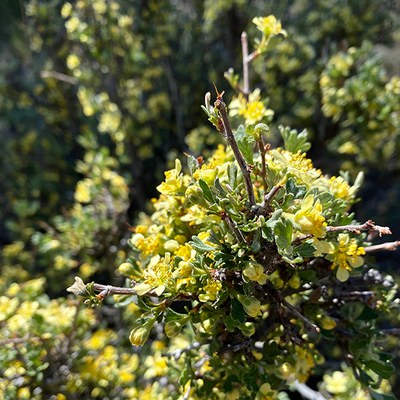
Other common names: Antelope-brush, Antelope bitterbrush
You've likely seen bitterbrush beinning to bloom! Bitterbrush is very common in our east-side forests. This shrub has rigid stems and grows to be 3-10 feet tall. Flowers are small with 5 yellowish petals. Leaves are thick and three-lobed with edges that roll under. Bitterbrush is an important food for wildlife that browse—think deer, elk, and pronghorn. The shrub is well-adapted to our area with water-loss resistant leaves and long taproots.
Bloom time: Late spring
Land Trust Preserves: You can see bitterbrush at Camp Polk Meadow Preserve, Indian Ford Meadow Preserve, and Whychus Canyon Preserve. Join a Land Trust outing to see these blooms at Willow Springs Preserve.
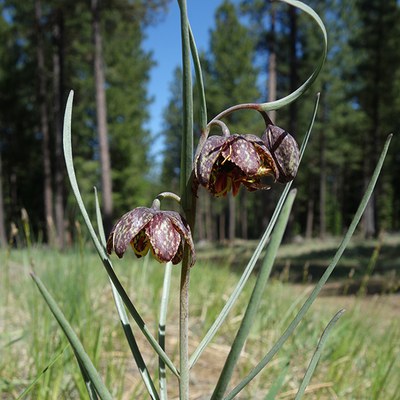
Other common names: Spotted mountain bells
Perhaps one of our most unusual lilies, the spotted fritillary is brown to greenish in color with yellow, red, or white markings. They grow in grasslands or Cascade foothill forests and can be hard to spot because of their subdued color. Just because they are subdued doesn’t mean they aren’t stunning! The beautiful spotting and delicate petals just beg for a closer look. Flowers hang downward or face outward with 1-3 blooms per stalk.
Bloom time: Late spring-early summer
Land Trust Preserves: You can see spotted fritillary at the Metolius Preserve and Indian Ford Meadow Preserve, as well as on an outing at the Metolius River Preserve.
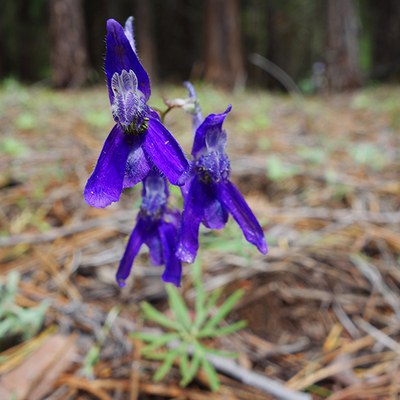
Other common names: Two-lobe larkspur, Upland larkspur, Nuttall's larkspur
One of the most wide-ranging flower species in North America, larkspur can be found from British Columbia and Alberta south to California, Arizona, and New Mexico. It grows in sagebrush desert, shrublands, and open conifer forests. Common larkspur has distinctive purple flowers 3/4 - 1 1/4” across with 5 sepals that look like petals. The uppermost petal has a long hollow spur that holds nectar. A cluster of 3-12 purple wildflowers are found on a slender stem 6-16” tall. Leaves are on the lowest part of the stem.
Bloom time: Early summer
Land Trust Preserves: You can spot larkspur at Indian Ford Meadow Preserve, the Metolius Preserve, and Whychus Canyon Preserve. Join a Land Trust outing to see these wildflowers at the Metolius River Preserve.
**Although we make every effort to be accurate in our flower identification, it is often difficult to tell the differences between subspecies from a photo.**
Learn more:
- Join the Land Trust for a wildflower hike.
- Some April wildflowers are still blooming. See what to look for.


